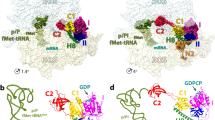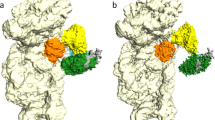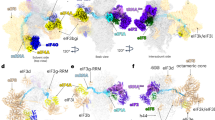Abstract
Eukaryotic and archaeal translation initiation factor 2 (e/aIF2) is a heterotrimeric GTPase that has a crucial role in the selection of the correct start codon on messenger RNA. We report the 5-Å resolution crystal structure of the ternary complex formed by archaeal aIF2 from Sulfolobus solfataricus, the GTP analog GDPNP and methionylated initiator tRNA. The 3D model is further supported by solution studies using small-angle X-ray scattering. The tRNA is bound by the α and γ subunits of aIF2. Contacts involve the elbow of the tRNA and the minor groove of the acceptor stem, but not the T-stem minor groove. We conclude that despite considerable structural homology between the core γ subunit of aIF2 and the elongation factor EF1A, these two G proteins of the translation apparatus use very different tRNA-binding strategies.
This is a preview of subscription content, access via your institution
Access options
Subscribe to this journal
Receive 12 print issues and online access
$189.00 per year
only $15.75 per issue
Buy this article
- Purchase on Springer Link
- Instant access to full article PDF
Prices may be subject to local taxes which are calculated during checkout



Similar content being viewed by others

Accession codes
References
Hinnebusch, A.G. Molecular mechanism of scanning and start codon selection in eukaryotes. Microbiol. Mol. Biol. Rev. 75, 434–467 (2011).
Jackson, R.J., Hellen, C.U. & Pestova, T.V. The mechanism of eukaryotic translation initiation and principles of its regulation. Nat. Rev. Mol. Cell Biol. 11, 113–127 (2010).
Algire, M.A., Maag, D. & Lorsch, J.R. Pi release from eIF2, not GTP hydrolysis, is the step controlled by start-site selection during eukaryotic translation initiation. Mol. Cell 20, 251–262 (2005).
Unbehaun, A., Borukhov, S.I., Hellen, C.U. & Pestova, T.V. Release of initiation factors from 48S complexes during ribosomal subunit joining and the link between establishment of codon-anticodon base-pairing and hydrolysis of eIF2-bound GTP. Genes Dev. 18, 3078–3093 (2004).
Dorris, D.R., Erickson, F.L. & Hannig, E.M. Mutations in GCD11, the structural gene for eIF-2γ in yeast, alter translational regulation of GCN4 and the selection of the start site for protein synthesis. EMBO J. 14, 2239–2249 (1995).
Erickson, F.L. & Hannig, E.M. Ligand interactions with eukaryotic translation initiation factor 2: role of the γ-subunit. EMBO J. 15, 6311–6320 (1996).
Huang, H.K., Yoon, H., Hannig, E.M. & Donahue, T.F. GTP hydrolysis controls stringent selection of the AUG start codon during translation initiation in Saccharomyces cerevisiae. Genes Dev. 11, 2396–2413 (1997).
Yatime, L., Schmitt, E., Blanquet, S. & Mechulam, Y. Functional molecular mapping of archaeal translation initiation factor 2. J. Biol. Chem. 279, 15984–15993 (2004).
Pedullà, N. et al. The archaeal eIF2 homologue: functional properties of an ancient translation initiation factor. Nucleic Acids Res. 33, 1804–1812 (2005).
Yatime, L., Mechulam, Y., Blanquet, S. & Schmitt, E. Structural switch of the γ subunit in an archaeal aIF2αγ heterodimer. Structure 14, 119–128 (2006).
Nika, J., Rippel, S. & Hannig, E.M. Biochemical analysis of the eIF2βγ complex reveals a structural function for eIF2α in catalyzed nucleotide exchange. J. Biol. Chem. 276, 1051–1056 (2001).
Naveau, M., Lazennec-Schurdevin, C., Panvert, M., Mechulam, Y. & Schmitt, E. tRNA binding properties of eukaryotic translation initiation factor 2 from Encephalitozoon cuniculi. Biochemistry 49, 8680–8688 (2010).
Schmitt, E., Blanquet, S. & Mechulam, Y. The large subunit of initiation factor aIF2 is a close structural homologue of elongation factors. EMBO J. 21, 1821–1832 (2002).
Yatime, L., Mechulam, Y., Blanquet, S. & Schmitt, E. Structure of an archaeal heterotrimeric initiation factor 2 reveals a nucleotide state between the GTP and the GDP states. Proc. Natl. Acad. Sci. USA 104, 18445–18450 (2007).
Roll-Mecak, A., Alone, P., Cao, C., Dever, T.E. & Burley, S.K. X-ray structure of translation initiation factor eIF2γ: implications for tRNA and eIF2α binding. J. Biol. Chem. 279, 10634–10642 (2004).
Sokabe, M., Yao, M., Sakai, N., Toya, S. & Tanaka, I. Structure of archaeal translational initiation factor 2 βγ–GDP reveals significant conformational change of the β-subunit and switch 1 region. Proc. Natl. Acad. Sci. USA 103, 13016–13021 (2006).
Stolboushkina, E. et al. Crystal structure of the intact archaeal translation initiation factor 2 demonstrates very high conformational flexibility in the α- and β-subunits. J. Mol. Biol. 382, 680–691 (2008).
Schmitt, E., Naveau, M. & Mechulam, Y. Eukaryotic and archaeal translation initiation factor 2: a heterotrimeric tRNA carrier. FEBS Lett. 584, 405–412 (2010).
Nissen, P. et al. Crystal structure of the ternary complex of Phe-tRNAPhe, EF-Tu, and a GTP analog. Science 270, 1464–1472 (1995).
Nikonov, O. et al. New insights into the interactions of the translation initiation factor 2 from archaea with guanine nucleotides and initiator tRNA. J. Mol. Biol. 373, 328–336 (2007).
Shin, B.S. et al. Initiation factor eIF2γ promotes eIF2–GTP–Met–tRNAiMet ternary complex binding to the 40S ribosome. Nat. Struct. Mol. Biol. 18, 1227–1234 (2011).
Schmitt, E., Panvert, M., Blanquet, S. & Mechulam, Y. Crystal structure of methionyl-tRNAfMet transformylase complexed with the initiator formyl-methionyl-tRNAfMet. EMBO J. 17, 6819–6826 (1998).
Ito, T., Marintchev, A. & Wagner, G. Solution structure of human initiation factor eIF2α reveals homology to the elongation factor eEF1B. Structure 12, 1693–1704 (2004).
Yatime, L., Schmitt, E., Blanquet, S. & Mechulam, Y. Structure-function relationships of the intact aIF2α subunit from the archaeon Pyrococcus abyssi. Biochemistry 44, 8749–8756 (2005).
Farruggio, D., Chaudhuri, J., Maitra, U. & RajBhandary, U.L. The A1 x U72 base pair conserved in eukaryotic initiator tRNAs is important specifically for binding to the eukaryotic translation initiation factor eIF2. Mol. Cell. Biol. 16, 4248–4256 (1996).
Kapp, L.D. & Lorsch, J.R. GTP-dependent recognition of the methionine moiety on initiator tRNA by translation factor eIF2. J. Mol. Biol. 335, 923–936 (2004).
Donahue, T.F., Cigan, A.M., Pabich, E.K. & Valavicius, B.C. Mutations at a Zn(II) finger motif in the yeast eIF-2β gene alter ribosomal start-site selection during the scanning process. Cell 54, 621–632 (1988).
Cigan, A.M., Pabich, E.K., Feng, L. & Donahue, T.F. Yeast translation initiation suppressor sui2 encodes the α subunit of eukaryotic initiation factor 2 and shares sequence identity with the human α subunit. Proc. Natl. Acad. Sci. USA 86, 2784–2788 (1989).
Ben-Shem, A., Jenner, L., Yusupova, G. & Yusupov, M. Crystal structure of the eukaryotic ribosome. Science 330, 1203–1209 (2010).
Selmer, M. et al. Structure of the 70S ribosome complexed with mRNA and tRNA. Science 313, 1935–1942 (2006).
Simonetti, A. et al. Structure of the 30S translation initiation complex. Nature 455, 416–420 (2008).
Julián, P. et al. The Cryo-EM structure of a complete 30S translation initiation complex from Escherichia coli. PLoS Biol. 9, e1001095 (2011).
Choi, S.K., Lee, J.H., Zoll, W.L., Merrick, W.C. & Dever, T.E. Promotion of met-tRNAiMet binding to ribosomes by yIF2, a bacterial IF2 homolog in yeast. Science 280, 1757–1760 (1998).
Kyrpides, N.C. & Woese, C.R. Universally conserved translation initiation factors. Proc. Natl. Acad. Sci. USA 95, 224–228 (1998).
Pestova, T.V. et al. The joining of ribosomal subunits in eukaryotes requires eIF5B. Nature 403, 332–335 (2000).
Mechulam, Y., Guillon, L., Yatime, L., Blanquet, S. & Schmitt, E. Protection-based assays to measure aminoacyl-tRNA binding to translation initiation factors. Methods Enzymol. 430, 265–281 (2007).
Kabsch, W.J. Evaluation of single-crystal X-ray diffraction data from a position-sensitive detector. J. Appl. Crystallogr. 21, 916–924 (1988).
Collaborative Computational Project, Number 4. The CCP4 suite: programs for protein crystallography. Acta Crystallogr. D Biol. Crystallogr. 50, 760–763 (1994).
Storoni, L.C., McCoy, A.J. & Read, R.J. Likelihood-enhanced fast rotation functions. Acta Crystallogr. D Biol. Crystallogr. 60, 432–438 (2004).
Barraud, P., Schmitt, E., Mechulam, Y., Dardel, F. & Tisne, C. A unique conformation of the anticodon stem-loop is associated with the capacity of tRNAfMet to initiate protein synthesis. Nucleic Acids Res. 36, 4894–4901 (2008).
Emsley, P., Lohkamp, B., Scott, W.G. & Cowtan, K. Features and development of Coot. Acta Crystallogr. D Biol. Crystallogr. 66, 486–501 (2010).
Adams, P.D. et al. PHENIX: a comprehensive Python-based system for macromolecular structure solution. Acta Crystallogr. D Biol. Crystallogr. 66, 213–221 (2010).
Laskowski, R.A., Mac Arthur, M.W., Moss, D.S. & Thornton, J.M. PROCHECK: a program to check the stereochemical quality of protein structure. J. Appl. Crystallogr. 26, 283–291 (1993).
David, G. & Perez, J. Combined sampler robot and high-performance liquid chromatography: a fully automated system for biological small-angle X-ray scattering experiments at the Synchrotron SOLEIL SWING beamline. J. Appl. Crystallogr. 42, 892–900 (2009).
Konarev, P.V., Volkov, V.V., Petoukhov, M.V. & Svergun, D.I. ATSAS 2.1, a program package for small-angle scattering data analysis. J. Appl. Crystallogr. 39, 277–286 (2006).
Svergun, D.I., Barberato, C. & Koch, M.H.J. CRYSOL - a program to evaluate X-ray solution scattering of biological macromolecules from atomic coordinates. J. Appl. Crystallogr. 28, 768–773 (1995).
Acknowledgements
This work was supported by the Physique et Chimie du Vivant program of Agence Nationale de la Recherche (MASTIC project).
Author information
Authors and Affiliations
Contributions
E.S. and Y.M. designed the research; E.S., M.P., C.L.-S., P.-D.C. and Y.M. carried out the experiments; E.S., Y.M., J.P. and A.T. analyzed the data; E.S. and Y.M. wrote the paper; and all authors contributed to editing the manuscript.
Corresponding author
Ethics declarations
Competing interests
The authors declare no competing financial interests.
Supplementary information
Supplementary Text and Figures
Supplementary Figures 1–6 and Supplementary Methods (PDF 1552 kb)
Rights and permissions
About this article
Cite this article
Schmitt, E., Panvert, M., Lazennec-Schurdevin, C. et al. Structure of the ternary initiation complex aIF2–GDPNP–methionylated initiator tRNA. Nat Struct Mol Biol 19, 450–454 (2012). https://doi.org/10.1038/nsmb.2259
Received:
Accepted:
Published:
Issue Date:
DOI: https://doi.org/10.1038/nsmb.2259
This article is cited by
-
Cryo-EM study of an archaeal 30S initiation complex gives insights into evolution of translation initiation
Communications Biology (2020)
-
Structural basis for the inhibition of translation through eIF2α phosphorylation
Nature Communications (2019)
-
Cryo-EM study of start codon selection during archaeal translation initiation
Nature Communications (2016)
-
Structure of mammalian eIF3 in the context of the 43S preinitiation complex
Nature (2015)
-
A SelB/EF-Tu/aIF2γ-like protein from Methanosarcina mazei in the GTP-bound form binds cysteinyl-tRNACys
Journal of Structural and Functional Genomics (2015)


